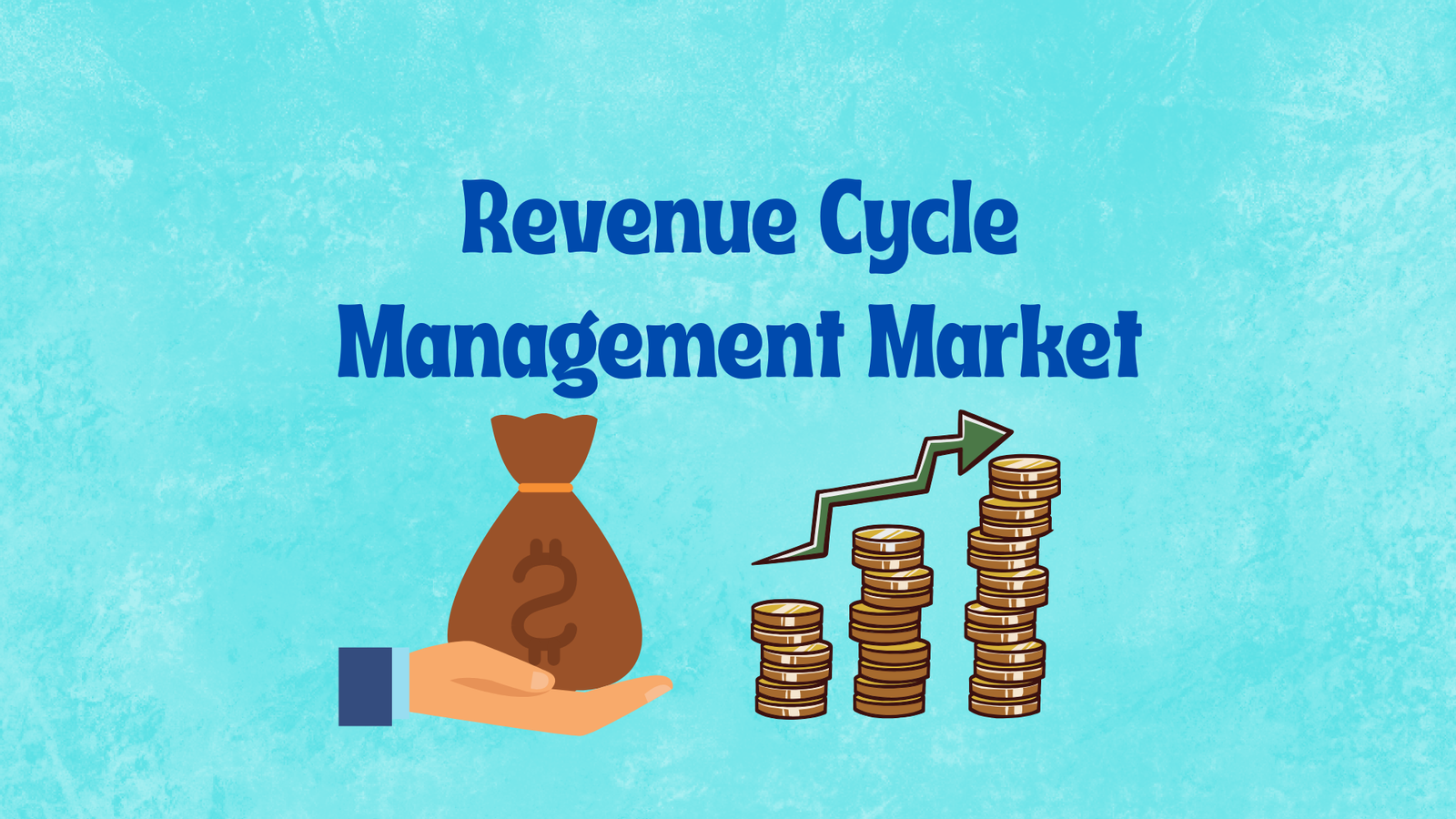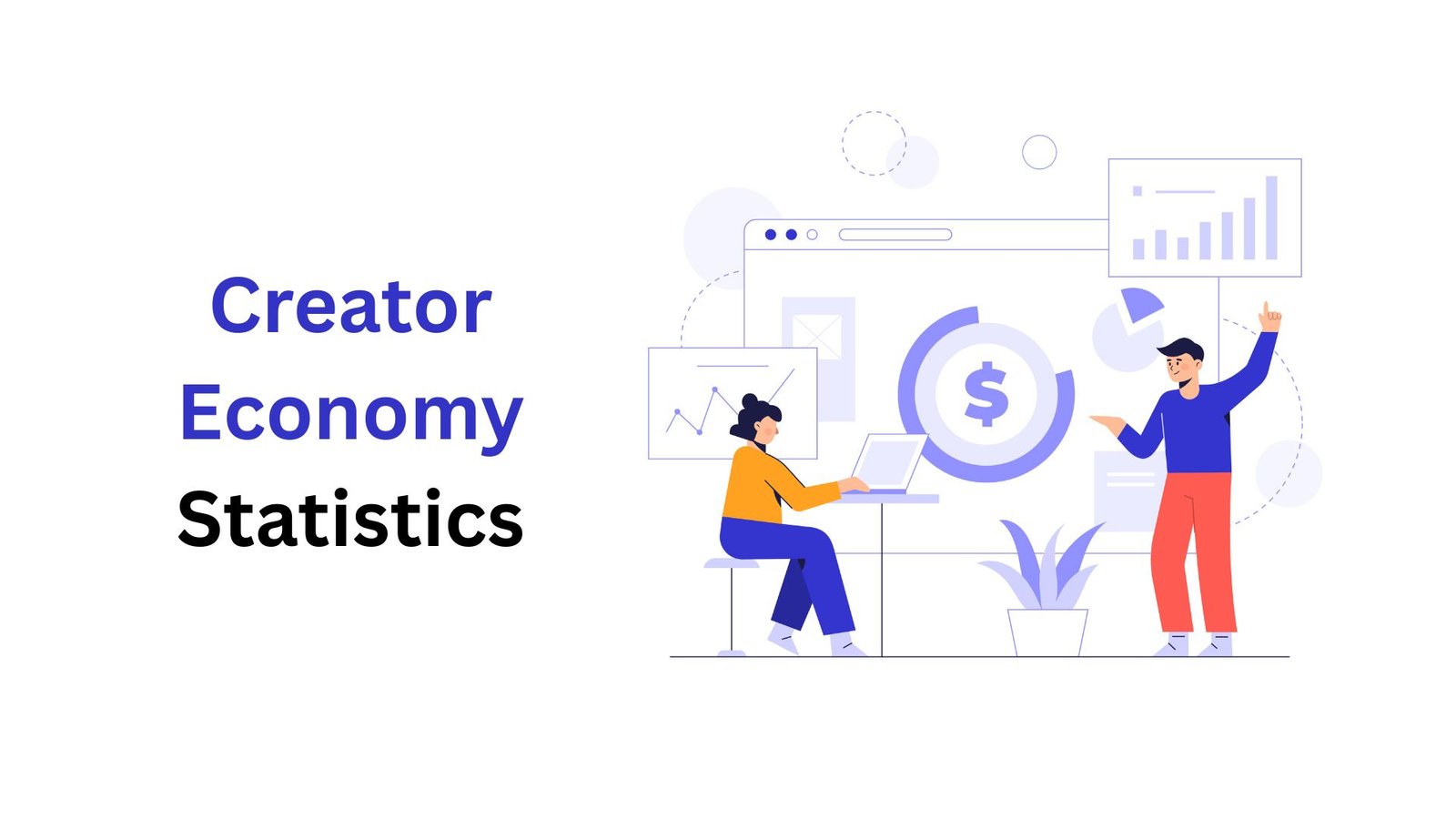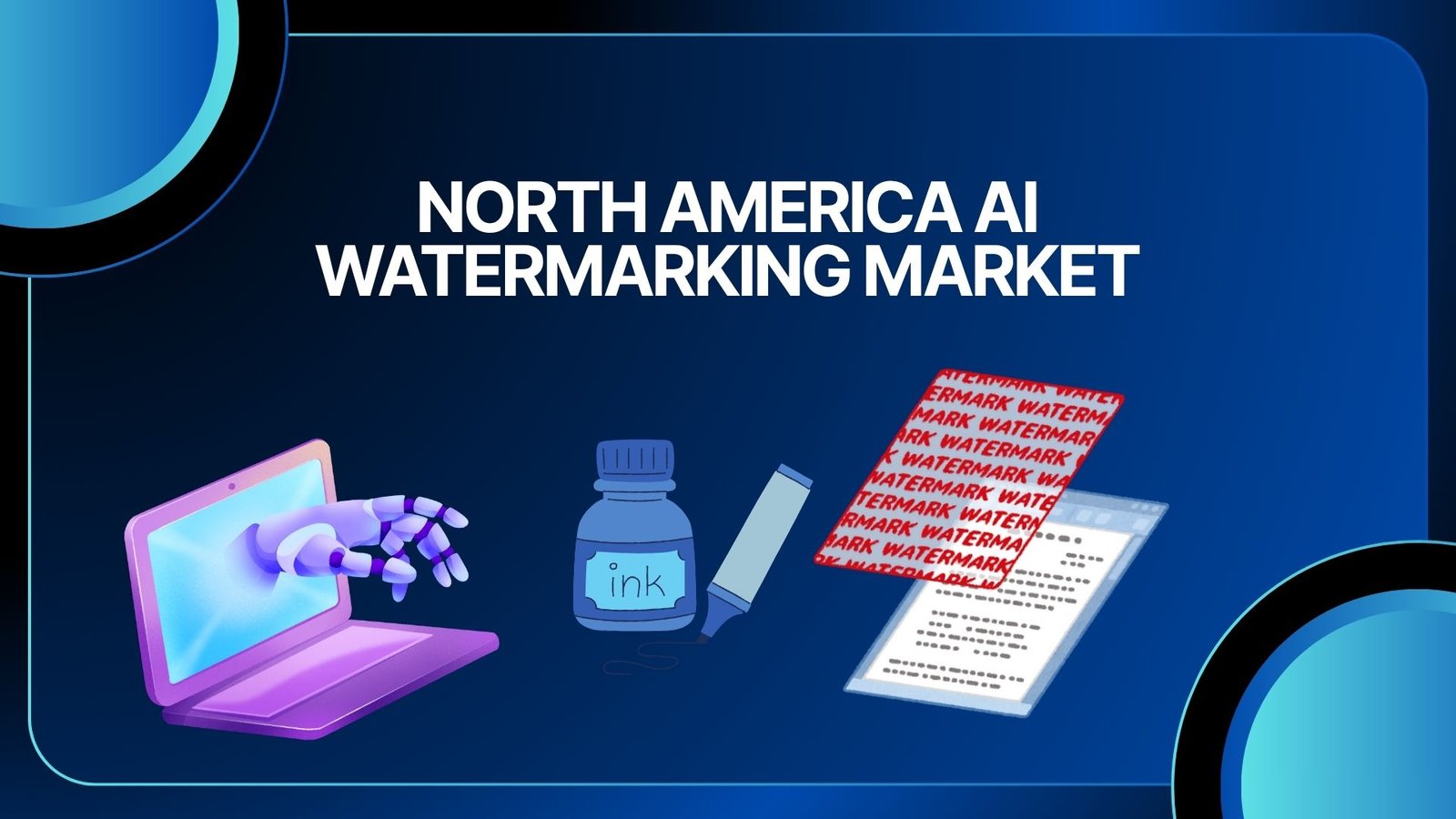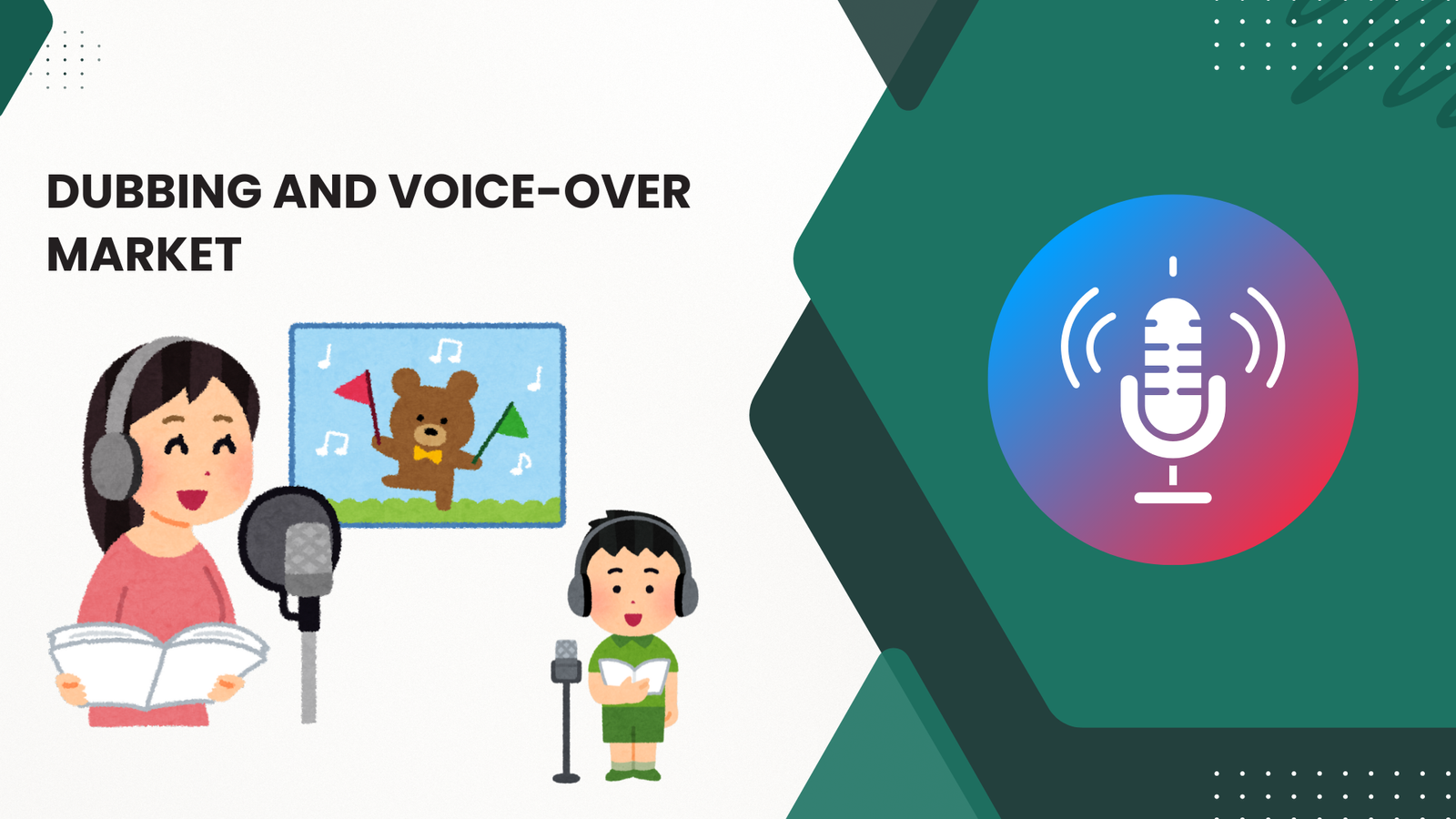Sales Training Statistics By Types, Effectiveness, Lead Nurturing, Impact, Benefits, Inside And Outside Sales
Updated · Sep 19, 2024

WHAT WE HAVE ON THIS PAGE
- Introduction
- Editor’s Choice
- Types Of Sales Training
- General Sales Training Statistics
- Sales Training Effectiveness
- Sales Productivity And Customer Experience Statistics
- Sales Lead Nurturing Statistics
- Follow-up Statistics
- Sales Training Adoption And Training Impact
- Inside Sales Statistics
- Outside Sales Statistics
- Benefits Of Sales Training
- Conclusion
Introduction
Sales Training Statistics: Sales training is about teaching salespeople the skills they need to sell products or services. This training can be done in several ways, such as in a classroom, online, or while working. It’s important because it helps salespeople learn the latest sales methods and best practices. It also helps them update their knowledge about products and understand the sales process better.
Despite its importance, many companies need more sales training. Some business owners think their sales team already knows how to sell and want to avoid the need for extra training. But statistics show that this isn’t always true. Many businesses could boost their revenue significantly by investing in better sales training for their employees. In this article, Sales Training Statistics, we’ll cover some key sales training features and points you should know!
Editor’s Choice
- Sales Training Statistics stated that almost 87% of sales training content is forgotten within 30 days without follow-up.
- Companies with a structured sales training program see 9% more growth in annual revenue.
- Only 32% of companies have a formal sales training program in place.
- Sales reps who get ongoing training make 50% more in net sales.
- 55% of sales professionals think their company’s sales training needs to be improved.
- Companies that offer continuous training have 50% higher net sales per employee.
- Sales teams that use gamification have seven times higher conversion rates.
- Just 17% of companies find their sales training to be effective.
- Sales reps who finish training courses have a 10% higher success rate in closing deals.
- 63% of sales leaders believe that virtual sales training is just as effective as in-person training.
- Companies that include video in their sales training see 65% more success in meeting sales goals.
- Sales reps need to remember 84% of training content after 90 days.
- Sales Training Statistics stated that only 15% of sales training content is remembered after 30 days.
- Companies that invest in sales training get a 353% return on their investment.
- 70% of sales leaders think their company’s sales training needs to be improved.
- A well-structured or dynamic coaching program makes salespeople 10% more likely to hit their sales targets. Effective coaching can improve success rates even more.
- Sales teams that get over two hours of coaching each week have a 56% success rate in closing deals.
- Companies with a formal coaching system reach their sales targets 91.2% of the time.
- Good sales training can increase win rates by up to 25% in some companies.
- Companies where managers spend more time coaching rather than selling have 8.2% better success rates and 5.2% higher total revenue.
- According to Rain Group, effective sales coaching can increase transaction sizes, win rates, and new leads by 25% to 40%.
- 79% of customers prefer dealing with salespeople who act as trusted advisors rather than just selling products and services.
- Up to 71% of customers expect to interact with salespeople early in the buying process.
- Companies that invest in good sales coaching see an 8.4% rise in revenue year-over-year, a 95% improvement compared to those without such coaching.
- Salespeople who use social media in their sales efforts meet their quotas 23% more often than those who don’t.
- Teams that invest in sales training technology perform 57% better than their competitors.
- Sales Training Statistics stated that companies with outdated sales onboarding programs see voluntary turnover rates rise from 7.9% to 14.2%.
- Salespeople with mobile access to CRM meet their annual sales goals 24% more often.
- Dynamic sales coaching results in significant improvements in sales performance, with a 21.3% increase in meeting quotas and a 19% boost in win rates.
- High-quality coaching has little effect on top performers and the lowest 10% of the sales team but can improve the performance of the middle 60% by up to 19%.
Types Of Sales Training
#1. Sales Training Programs
- Sales training programs are meant to help salespeople and sales managers improve their skills.
- The best programs don’t just offer a one-time lesson; they provide continuous support to ensure long-term improvement.
- These programs should match the company’s main goals to ensure targets are achieved, and progress is measurable.
- Training can cover many areas, including consultative selling, prospecting, negotiating, and sales management.
#2. Sales Coaching
- Sales coaching is key to making sure the training is used effectively in real sales situations.
- Coaching helps salespeople improve their skills, close sales, grow accounts, and meet goals.
- Often, coaching is overlooked after investing in training.
- Research shows that salespeople are 63% more likely to be top performers when they have:
- A good sales manager
- Regular coaching
- Effective training
With all of these, reaching top performance is easier. Good coaching helps sellers and teams build skills, reinforce learning, and stay accountable for meeting goals.
#3. Sales Consulting
- Your leadership team might have ideas for boosting sales, but with so many priorities, such as people, structure, and processes, it’s tough to know where to start.
- An experienced sales consultant can offer expert advice on how to increase revenue and provide a clear plan to help your company reach its potential.
#4. Licensing
- A license can give your whole sales team access to a complete sales training curriculum, maximizing your training investment.
- For example, RAIN Group offers a Total Access license that gives your team access to a full range of training programs, online learning, and performance tools.
#5. Train the Trainer
- The success of a training program often depends on how well the trainers do their job.
- Trainers need to engage participants and be seen as experts. A “Train the Trainer” program allows your team members to be trained to deliver sales programs.
- For example, RAIN Group’s Train the Trainer process certifies your trainers to use their sales methods, giving you more control over training and ensuring trainers are well-prepared.
#6. Reinforcement
To make sure salespeople keep and use new skills, reinforcement is necessary. This can be done through:
- Assignments
- Coaching
- Gamification
- Micro-learning
- AI tools
Reinforcement helps build new habits and integrate skills into everyday selling.
Results are important because 77% of what is learned can be forgotten within six days if it’s not reinforced.
General Sales Training Statistics
- Sales Training Statistics stated that U.S. companies spend around $70 billion each year on training.
- Companies that put money into training are 57% more successful at sales compared to their rivals.
- Sales training can increase a sales rep’s performance by an average of 20%.
- Sales training delivers a huge 353% return on investment (ROI). In other words, for every $1 spent on training, you can get up to $4.53 back!
- Continuous training leads to 50% higher net sales per sales rep. Ongoing training, not occasional seminars, is key to building successful sales teams.
- 80% of top-performing sales teams rate their training as very good or excellent. This shows that effective training programs help create high-performing teams.
- High-growth companies are twice as likely to offer tailored training for sales roles, and customized training is considered the future.
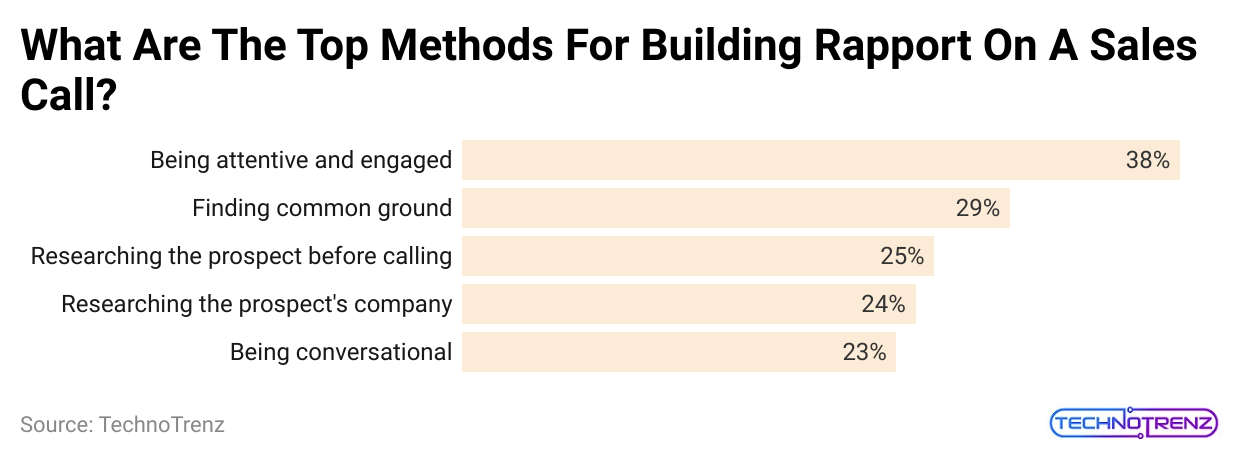
(Reference: hubspot.com)
- Instead of one-size-fits-all programs, companies should offer personalized training that matches each rep’s skills and interests.
- Sales Training Statistics stated that only 17% of companies think their training programs are effective.
- More than 25% of sales reps feel their training could be more helpful for their productivity.
- Many training programs only cover basic skills, leaving reps to learn on their own.
- Companies spend about $10,000 to $15,000 to hire one employee but only $2,000 on annual sales training. Insufficient funding affects the quality of the training, which is a major reason why many sales reps are disappointed with their training.
- Nearly 70% of salespeople say they haven’t received formal sales training and are “self-taught.” This highlights a big opportunity for businesses that offer sales training services.
- Almost 50% (46%) of sales reps didn’t originally plan to work in sales.
- Many junior sales reps need solid coaching since they may need to gain natural selling skills from the start.
- 84% of sales professionals forget most of their training within three months.
- Ongoing training is crucial. To compete with high-growth companies, invest in continuous training for your sales team.
- For 59% of American companies, the biggest challenge in providing effective sales training is accountability.
- Without holding sales reps accountable for using their training, it often fails to make an impact.
- Sales enablement can boost sales by 6% to 20%. Successful sales organizations invest in sales enablement services.
Sales Training Effectiveness
- Companies offering ongoing sales training see 50% higher sales per employee.
- Sales Training Statistics stated that around 91% of companies think their sales training programs need improvement.
- Sales Training Statistics stated that almost 57% of sales reps expect to fall short of their sales targets.
- Businesses with regular sales training achieve 20% higher win rates.
- 75% of executives consider building a strong sales team a top priority.
- Companies investing in sales training enjoy a 24% higher profit margin.
- Only 48% of sales reps reach their quotas.
- 67% of sales reps need to meet their quotas as per Sales Training Statistics.
- Salespeople get an average of 94 hours of training per year.
- Companies investing in sales training achieve 35% higher quota fulfillment.
- Sales Training Statistics stated that companies investing in sales training see a 200% boost in revenue.
- 47% of top-performing companies provide over 31 hours of training annually.
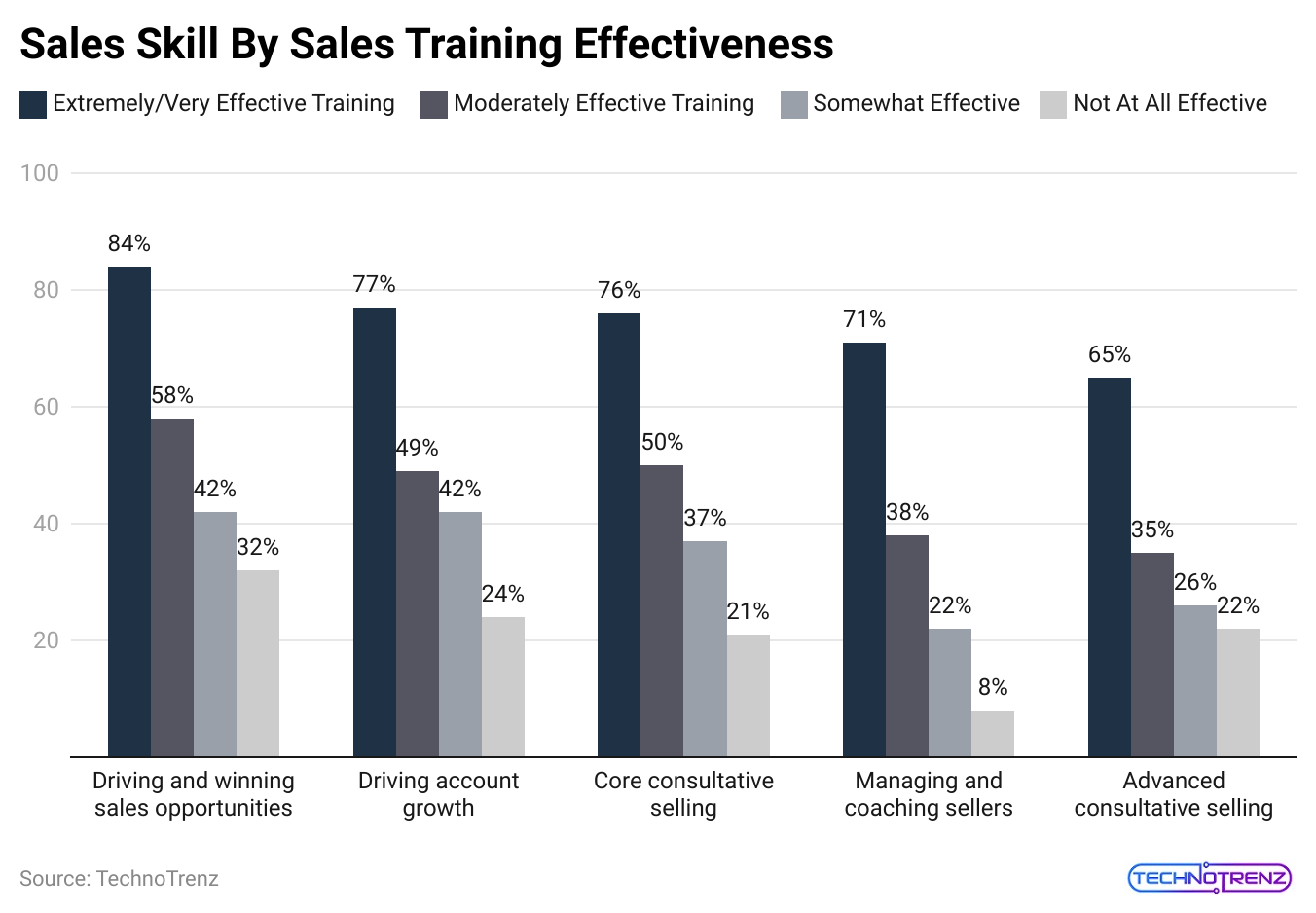
(Reference: rainsalestraining.com)
| Extremely/Very Effective Training | Moderately Effective Training | Somewhat Effective | Not At All Effective | |
|
Driving and winning sales opportunities |
84% | 58% | 42% | 32% |
| Driving account growth | 77% | 49% | 42% |
24% |
|
Core consultative selling |
76% | 50% | 37% | 21% |
| Managing and coaching sellers | 71% | 38% | 22% |
8% |
|
Advanced consultative selling |
65% | 35% | 26% |
22% |
- Employees become 12% more productive with sales training, as stated in Sales Training Statistics.
- Effective sales training programs result in 22.7% higher win rates.
- 77% of buyers won’t engage with a salesperson who can’t show product knowledge.
- Sales Training Statistics stated that almost 81% of sales reps believe their training directly helps them close deals.
- Salespeople receiving more than 3 hours of coaching each month exceed their quotas by 7%, compared to 5% for those with less than 2 hours.
- Salespeople who use social selling are 40% more likely to meet their quotas.
- 76% of sales reps find overcoming objections their biggest challenge.
- Companies offering ongoing sales coaching achieve 28% higher win rates.
- Only 21% of companies have highly effective sales training programs.
- 75% of sales reps feel they need more skills to succeed.
- Companies with a formal sales process see greater revenue growth.
- 80% of top sales teams invest in sales coaching.
- Sales Training Statistics stated that almost 63% of sales teams say lead generation is their biggest challenge.

(Reference: rainsalestraining.com)
| Extremely/Very Effective Training | Moderately Effective Training | Somewhat Effective | Not At All Effective | |
|
People in selling roles have a positive attitude about their role in selling. |
90% | 72% | 57% | 36% |
| Our culture drives and supports sellers’ motivation to succeed | 80% | 62% | 37% |
26% |
|
People in selling roles actively pursue top-performance |
80% | 60% | 48% | 32% |
| People in selling roles display passion, hustle and intensity | 78 | 58% | 42% |
36% |
- Only 32% of reps believe they have the skills needed to succeed in their roles.
- 76% of effective sales training programs include sales playbooks.
- Nearly 72% of companies with formal sales processes exceed their revenue goals.
- Sales Training Statistics stated that around 70% of sales teams using digital sales tools perform better than others.
- Only 44% of executives think their company manages sales enablement well.
- Companies with onboarding programs see 25% higher revenue compared to those without.
- Only 20% of companies prioritize sales training in their budgets.
- Companies investing in sales training achieve 46% better sales performance.
- Companies with sales coaching programs see a 16.7% increase in annual revenue.
- Only 12% of salespeople think their organization does a good job onboarding new hires.
- Only 53% of salespeople meet their sales quotas as per Sales Training Statistics.
- Sales Training Statistics stated that almost 40% of salespeople find it harder to get responses from prospects than before.
- Companies investing in sales enablement see a 12% increase in deal size.
Sales Productivity And Customer Experience Statistics
- The average B2B buying group in large companies includes between 5 and 11 people representing about five different business functions.
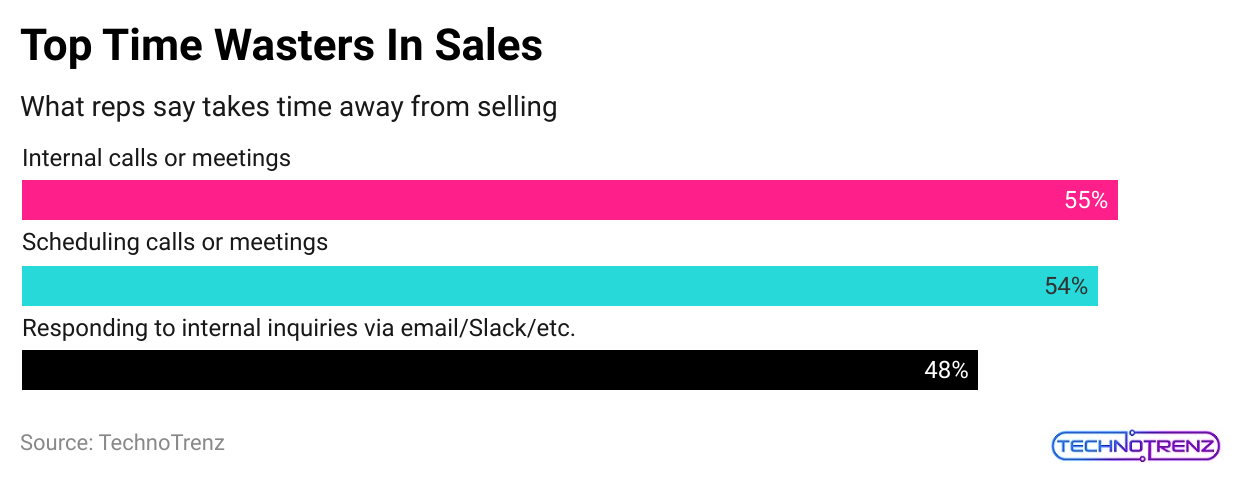
(Reference: dooly.ai)
- Once you’re talking to a decision-maker, it usually takes six calls to make a sale.
- 80% of sales happen after the fifth call, as per Sales Training Statistics.
- The best time to make a sales call is within an hour of receiving an initial inquiry.
- Only 7% of companies respond within 5 minutes of a prospect’s form submission. However, quick responses are crucial—35% to 50% of sales go to the company that replies first.
- While the number of buying interactions slightly increased each year (e.g., from 16 to 17 between 2017 and 2019), it jumped from 17 to 27 during the pandemic.
- 86% of salespeople say they lost or delayed at least one deal last year because a key client stakeholder left the company.
- Almost 40% of sellers have closed deals over $500,000 without ever meeting the customer in person.
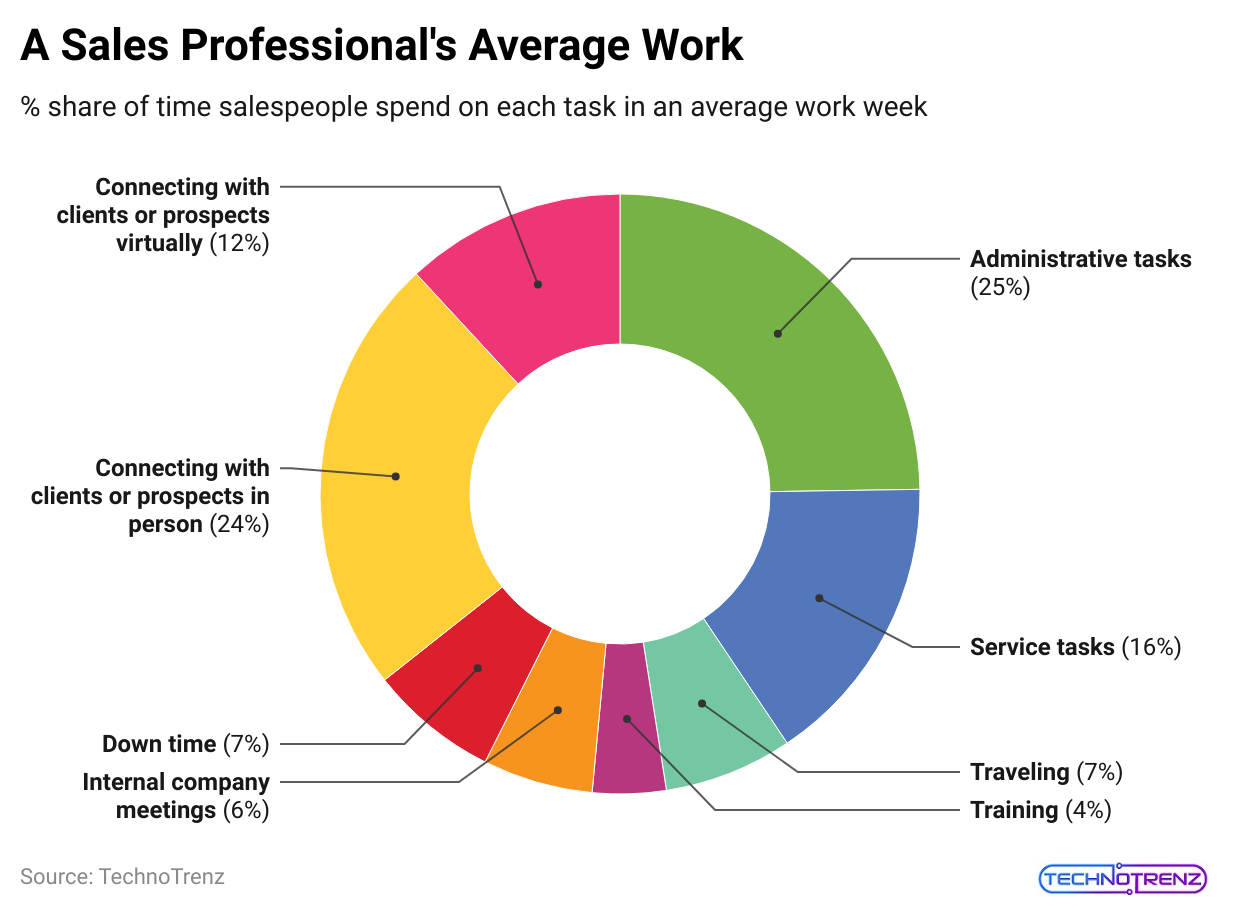
(Reference: websiteplanet.com)
- In B2B sales, 84% of buyers begin the purchasing process with a referral.
- Sales Training Statistics stated that stated that peer recommendations influence 90% of all B2B buying decisions.
- Customers referred to a company have an 18% lower churn rate than those acquired through other methods.
- Customers acquired through referrals have a 37% higher retention rate and are four times more likely to make a purchase.
- 81% of sales reps say buyers are doing more research on their own before making contact.
- 87% of business buyers expect sales reps to act as trusted advisors.
- If the information on the vendor’s website and sales reps is consistent, buyers are 2.8 times more likely to purchase.
Sales Lead Nurturing Statistics
- Companies that are good at lead nurturing have 9% more sales reps hitting their quotas.
- Businesses that use marketing automation for nurturing prospects see a 451% increase in qualified leads.
- Nurtured leads result in 20% more sales opportunities.
- Leads that are nurtured spend 47% more than leads that aren’t.
- Emails focused on lead nurturing have an average click-through rate (CTR) of 8%, while general emails have a CTR of 3%.
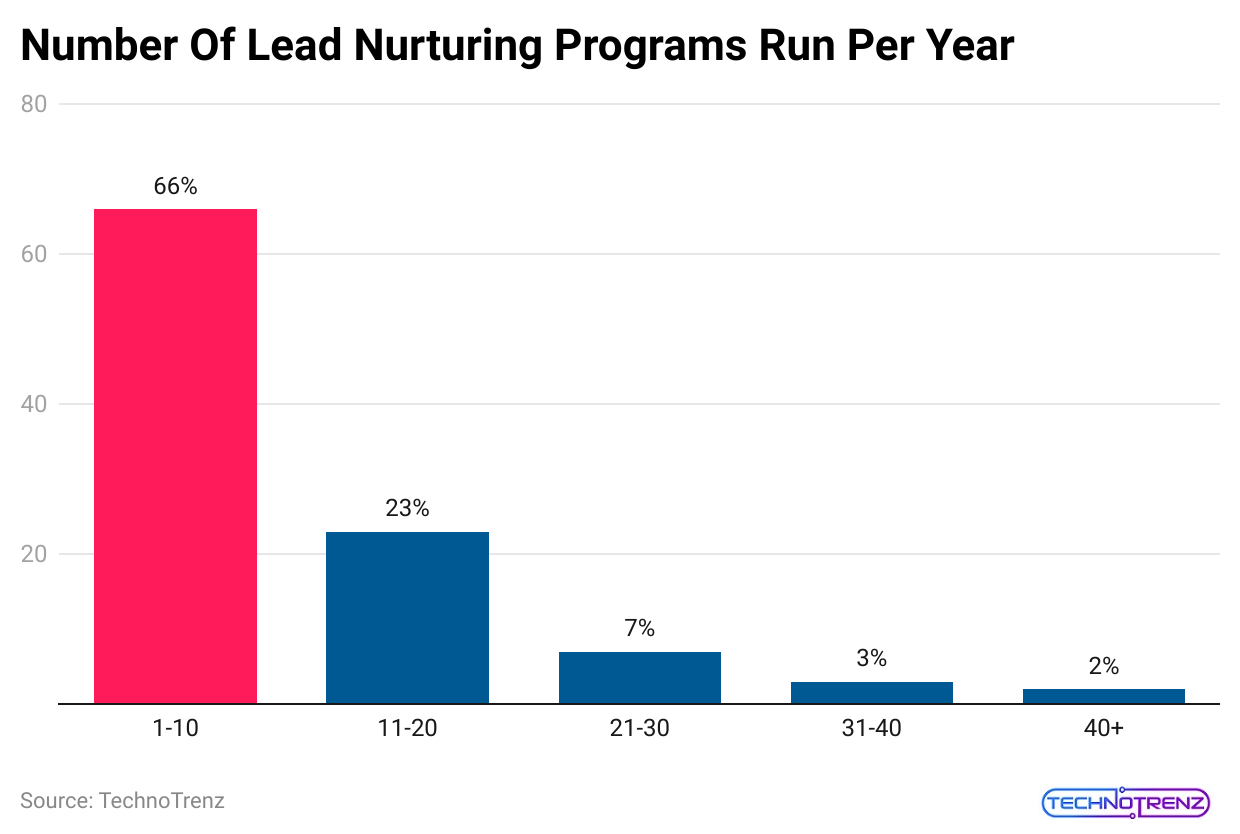
(Reference: 99firms.com)
| Number | % |
|
1-10 |
66% |
| 11-20 |
23% |
|
21-30 |
7% |
| 31-40 |
3% |
|
40+ |
2% |
- 78% of decision-makers say they’ve scheduled an appointment or attended an event due to a cold email or call.
- High-growth companies typically have 16 touchpoints with each prospect over a 2 to 4-week period.
- 63% of prospects who request information today won’t purchase for at least three months, and 20% will take over a year to buy.
- 58% of buyers say that most sales meetings aren’t valuable, and they want more focus on the value you can offer.
- 69% of buyers are more likely to connect with a sales rep if they receive relevant primary research data.
- Sales Training Statistics stated that almost 54% of buyers want a product demo during the first call.
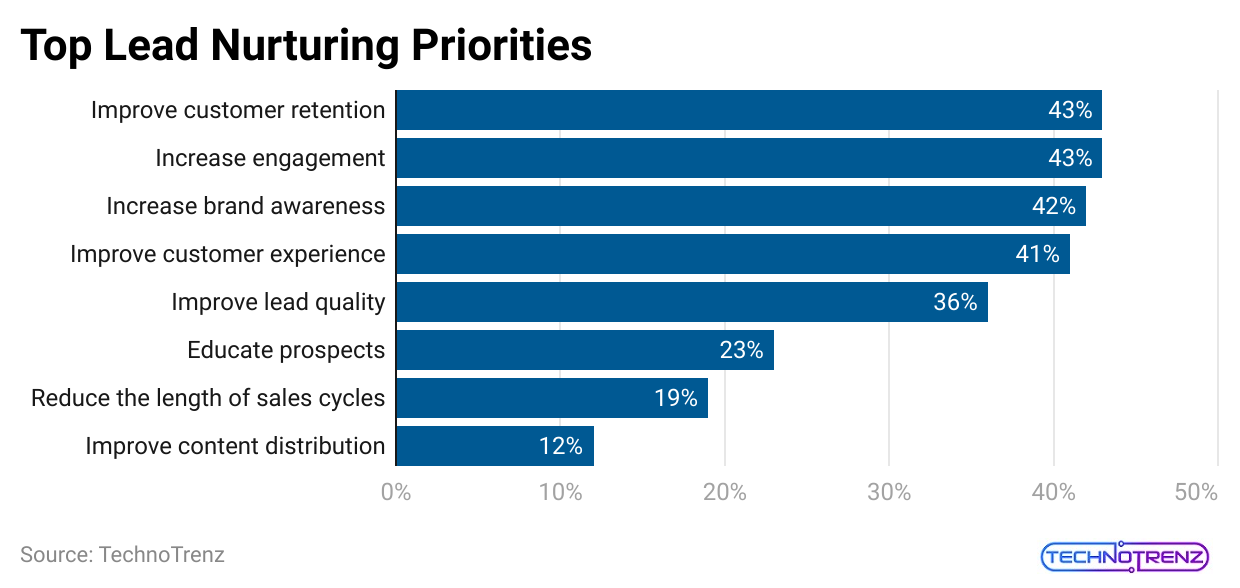
(Reference: 99firms.com)
| Lead Nurturing Priorities | % |
|
Improve customer retention |
43% |
| Increase engagement |
43% |
|
Increase brand awareness |
42% |
| Improve customer experience |
41% |
|
Improve lead quality |
36% |
| Educate prospects |
23% |
|
Reduce the length of sales cycles |
19% |
| Improve content distribution |
12% |
- 58% of buyers want to discuss pricing in the first sales call, but only 23% of sales reps are willing to do so.
- Buyers say the most important parts of a good sales experience are 1) a rep who listens to their needs, 2) a rep who isn’t pushy, and 3) relevant information.
- Sales teams are twice as likely to prioritize leads based on data about their likelihood to buy rather than just relying on gut feelings.
Follow-up Statistics
- Only 8.5% of outreach emails get a response. If you contact the same person several times, you’ll get twice as many replies.
- To run a successful outreach campaign, plan to contact multiple prospects multiple times. This approach can increase your response rates by 160%.
- Most prospects prefer communicating via email over the phone, text, social media, or in person. 80% of prospects like emails best.
- B2B sellers should still call prospects directly. Over 50% of decision-makers prefer phone calls.
- If your team is among the 48% of salespeople who never make follow-up calls, you should change your approach. 80% of sales need five follow-up calls to succeed.

(Source: notta.ai)
- There are better times for making cold calls. The best times to qualify leads are between 4 p.m. and 5 p.m. or between 11 a.m. and 12 p.m.
- Certain days are better for contacting prospects. Thursday is the best day, followed by Wednesday. Tuesday is the least effective day for cold calling.
- Social selling is very effective. Salespeople who use social selling are 66% more likely to meet their sales goals compared to those who use traditional methods.
- 78% of salespeople who use social media outperform their peers.
- Using social selling can boost win rates by 5% and increase deal sizes by 35%.
- Looking at social media platforms, Companies get 80.3% of their B2B buyers from LinkedIn, 12.7% from Twitter, and 6.7% from Facebook.
- Only 7% of companies reply within 5 minutes of receiving a prospect’s form submission. 50% don’t respond until five business days later.
- This delay can cost you sales—35% to 50% of sales go to the company that responds first.
- Using live chat can help you respond within 5 minutes. If you don’t offer live chat, you’re behind the curve.
- By the end of this year, 85% of companies are expected to use live chat for support.
Sales Training Adoption And Training Impact
- Only 32% of companies have a formal sales training program.
- Sales reps who get ongoing training close 7% more deals.
- Sales reps who receive ongoing training have 24% higher profit margins.
- Nearly 82% of sales leaders think their teams need more training on sales tools.
- Only 44% of companies measure how much money they make from their sales training programs.
- Sales Training Statistics stated that only 35% of companies offer sales training more than once a year.
- Nearly 29% of companies connect their sales training with their customer management system (CRM).
- Almost 19% of companies use artificial intelligence (AI) to check how well their sales training works.
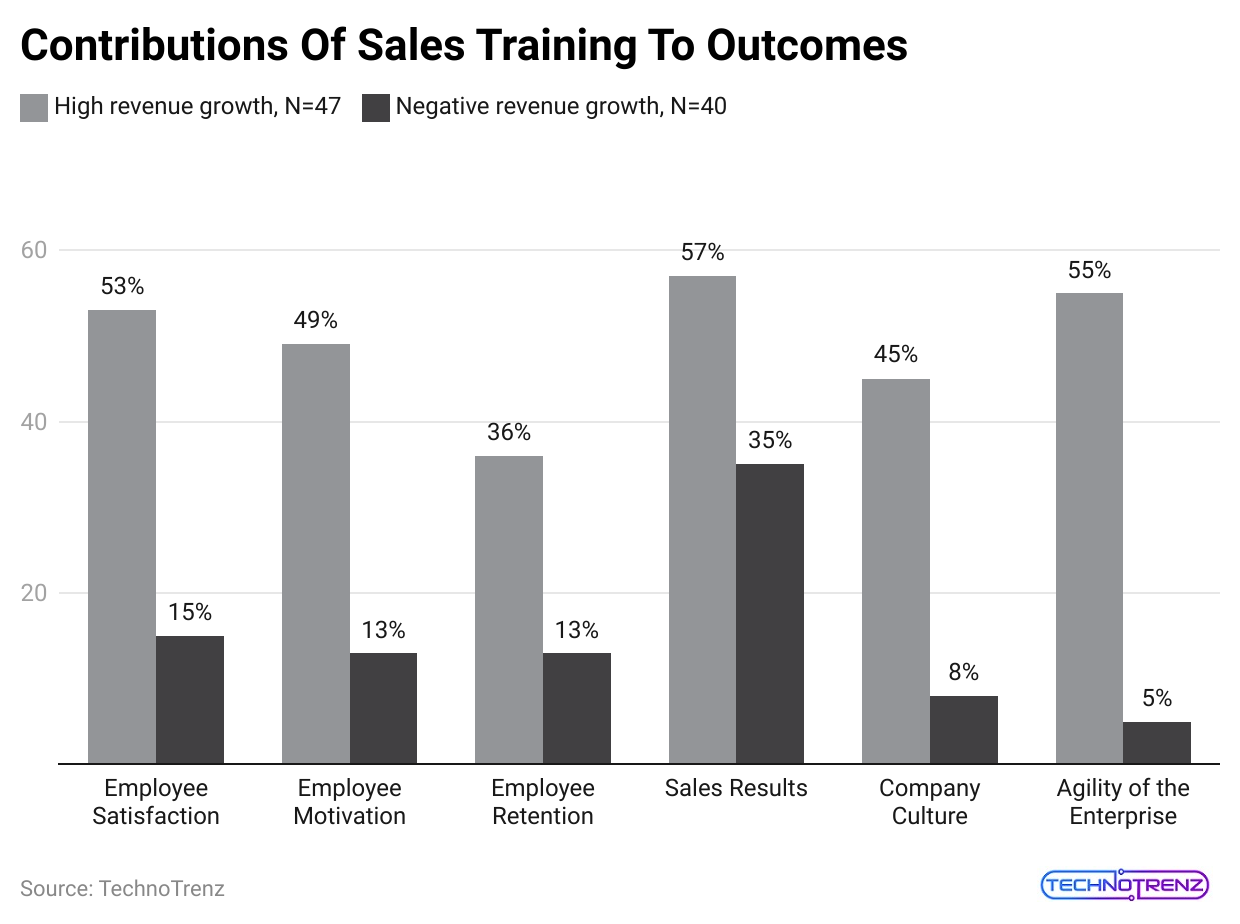
(Reference: forbes.com)
- Companies with a structured sales training process see a 9% increase in yearly revenue.
- Sales reps who receive ongoing training make 50% more in net sales, and companies that offer continuous training achieve 50% higher net sales per employee.
- Sales reps who complete training courses have a 10% higher success rate in closing deals.
- Companies that invest in sales training get a 353% return on their investment (ROI).
- Sales reps who receive ongoing coaching meet their sales goals 26% more often.
- Sales Training Statistics stated that the sales reps who get regular feedback improve their performance by 39%.
- Sales reps who receive ongoing training are 57% more likely to meet their sales goals.
- Companies that provide continuous training see 50% higher customer retention rates.
- Sales reps who get ongoing training are 33% more likely to be top performers.
- Sales reps who receive ongoing training are 69% more likely to stay with their company and 52% more likely to meet their sales targets.
- Sales reps who get ongoing training are 41% more likely to achieve their revenue goals.
- Sales reps who receive ongoing training are 67% more likely to get promoted.
- Sales reps who get ongoing training are 58% more likely to become top performers.
Inside Sales Statistics
- Average Conversion Rate: Inside sales are expected to have an average conversion rate of about 20% in 2024, indicating improved skills in digital sales.
- Conversion by Industry: Conversion rates differ by industry. The tech and healthcare sectors tend to have higher rates because of the greater need for digital and remote solutions.
- Best Call Times: The best times to make sales calls are between 10 am and 11 am and again from 4 pm to 5 pm when prospects are most likely to make a decision.
- Call Duration: Successful inside sales calls usually last between 7 to 10 minutes, balancing useful information with the prospect’s time.
- Effect on Conversions: Responding to leads within 5 minutes can increase conversion chances by up to 400%. Waiting more than 30 minutes greatly reduces the chance of converting the lead.
- Number of Contacts: On average, it takes about five follow-ups after the initial contact to close most sales, highlighting the need for consistent follow-up.
- Follow-Up Timing: Following up within the first hour is seven times more effective than waiting 24 hours.
- Open Rates: Sales emails typically have an open rate of around 18%. Personalized subject lines can boost open rates by up to 50%.
- Click-Through Rates: Personalized emails achieve a 14% click-through rate and increase conversions by 10%.
- CRM Usage: 91% of companies with more than 11 employees use CRM systems to improve their sales processes, showing how important technology is in managing sales.
- Automation Tools: Sales teams using automation software see a 14% boost in productivity and a 12% drop in overall sales costs.
- Ongoing Training: Continuous training for inside sales teams can boost sales by up to 50% per sales rep.
- Training Investment: Companies that regularly invest in sales training achieve 24% higher profit margins compared to those that spend less.
Outside Sales Statistics
- Comparison with Inside Sales: Outside sales cycles usually take 30-40% longer than inside sales cycles. This is because outside sales involve more complex deals and face-to-face meetings.
- Average Duration: Typically, outside sales cycles last between 45 and 90 days, depending on the industry and the complexity of the product or service.
- Larger Deal Values: Deals in outside sales are generally larger, often worth more than double the amount of deals in inside sales.
- Impact on Strategy: Bigger deals require more personalized management and longer-term strategies to build relationships.
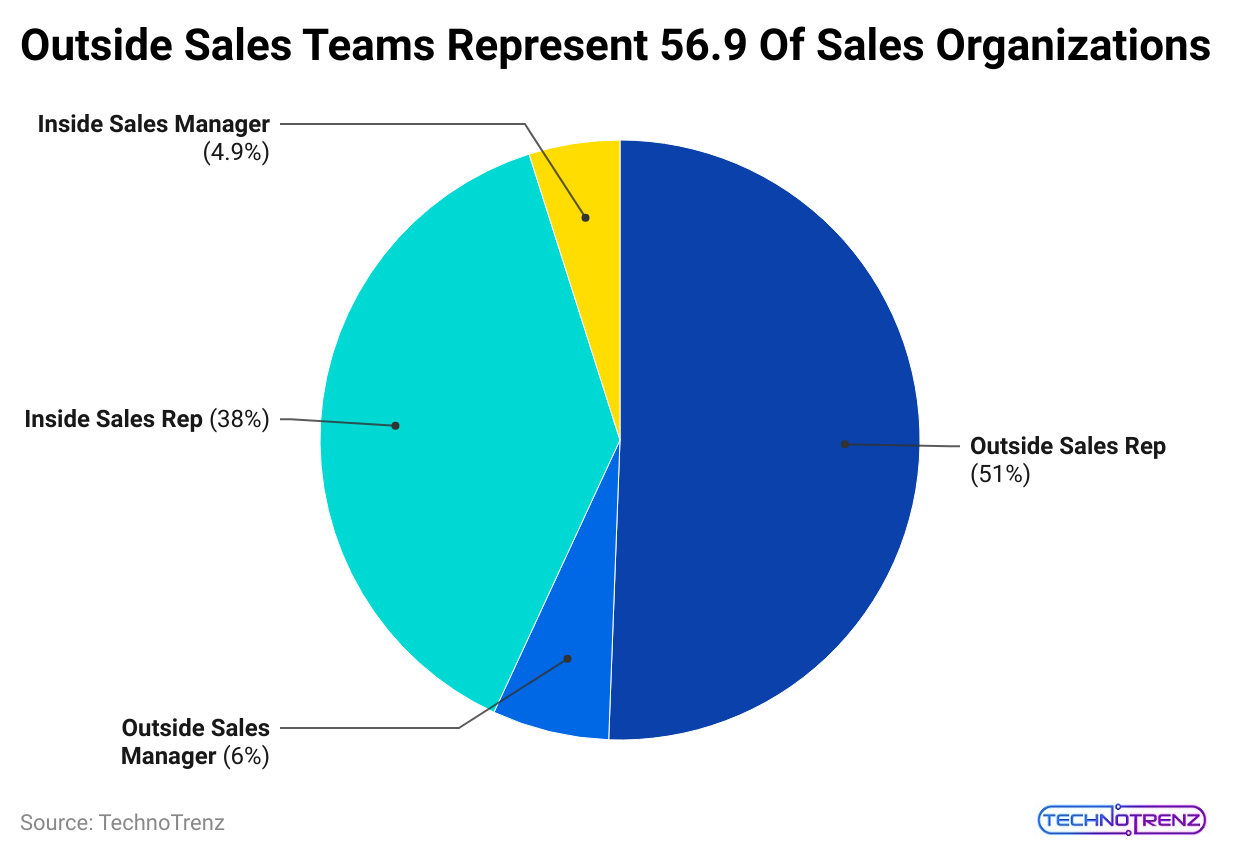 (Reference: people.ai)
(Reference: people.ai)
- Budget Allocation: Companies spend about 12% of their total sales budget on travel and expenses for outside sales, which covers costs for face-to-face meetings.
- ROI on Travel: Managing travel expenses well can lead to up to a 20% return on investment, thanks to better relationship building and more successful deals.
- Meeting Effectiveness: Face-to-face meetings have a closing rate of around 40%, which is much higher than that of remote meetings.
- Average Meetings Per Sale: In outside sales, it usually takes 3 to 5 in-person meetings to close a deal, which shows the importance of each meeting.
- Sales Coverage: Properly managing sales territories can increase sales by up to 15%. This ensures sales reps cover the right areas without overlap.
- Technology Use: Using geographic data and CRM tools for managing territories can boost sales efficiency by reducing travel time and making customer interactions more targeted.
- Mobile Technology Adoption: Over 70% of outside sales reps use mobile technology to access CRM data and sales materials on the go, which helps them respond quickly and be better prepared for client meetings.
- Digital Presentation Tools: Using digital tools during presentations can increase conversion rates by 20%, making sales pitches more engaging and effective.
- Skill Enhancement: Continuous training in negotiation and relationship management can boost deal closure rates by up to 25% for outside sales teams.
- Investment in Development: Companies that invest in regular, advanced training for their outside sales teams see a 30% increase in revenue growth.
Benefits Of Sales Training
- When sales training is done well, it can change how salespeople work and lead to better business outcomes.
As per Sales Training Statistics, very effective sales training is linked to three key results:
- Win Rates: Teams with very effective sales training have win rates that are 7 to 11 percentage points higher than teams with less effective training.
- Sales Goals: 76% of teams with highly effective training meet their sales goals, compared to just 31% of teams with the least effective training.
- Premium Pricing: 91% of teams with top-notch training can charge higher prices, while only 43% of teams with less effective training achieve this.
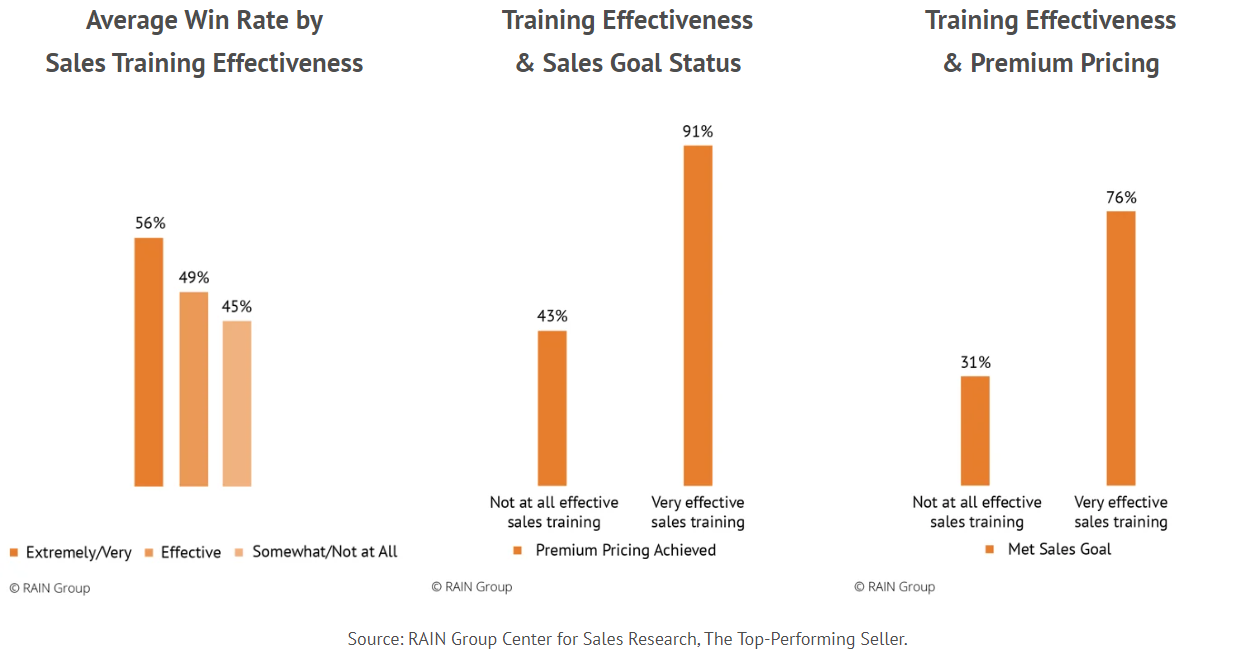 (Source: rainsalestraining.com)
(Source: rainsalestraining.com)
Effective sales training can lead to several important benefits for a company, including:
- Higher Win Rates: Winning more sales deals.
- Larger Sales: Increasing the average amount of each sale.
- Premium Pricing: Being able to charge higher prices.
- Better Profit Margins: Improving how much profit you make from each sale.
- Account Growth: Expanding business with current customers.
- New Business: Gaining more new customers.
- Sales Culture: Creating a strong culture focused on achieving sales goals.
- Effective Leadership: Making sales leaders and managers more effective.
- To get these results, companies need to make sure their sales training matches their business goals.
- They should work closely with their training providers or internal teams to determine the best way to achieve these goals.
- The exact benefits will vary by company, but the ones listed above are examples of what good sales training can achieve.
- Use this kind of framework to assess your current sales training and see how you can improve with a strong training program.
| Current State east | New Reality |
|
Training includes a mixture of methods or confused issues. |
Efficient sales training ensures that a proper method is embedded in the company and that results are seen. |
| Sales managers need to motivate the top performers from the sellers. |
Good sales management and coaching training helps managers get the best performance from their sales teams. It keeps the team motivated, focused, and productive. Managers who coach their team regularly can achieve significant sales wins and steady account growth. |
|
Salespeople generally need help to have effective sales conversations and to deliver the highest value to their buyers. |
Sales conversation training boosts the success of sales discussions. It helps salespeople inspire buyers, share engaging stories, and present ideas effectively. As a result, salespeople consistently build, communicate, and sell value well. |
|
Training is boring and monotonous. |
The training is interesting and can be easily adjusted to fit actual sales situations. |
| Training does not develop the seller’s skills. |
A competency-based training method involves certification and can be easily adapted to fit your company’s and salespeople’s specific needs. |
|
Salespeople spend too much time away from their jobs and face high travel expenses to attend training that could work better. |
Effective sales training reduces the time salespeople spend away from their fieldwork by using a blend of in-person and online instructor-led sessions, along with other training methods. |
| Present training techniques fail to change the position quo and get results. |
The training staff delivers efficient training, drives changes, and gives results. |
Sales Team Training Prioritization
- 47% of organizations say making sales more effective is a top priority for sales training.
- The most common sales training topics are product knowledge (70%), sales processes (63%), and industry knowledge (56%).
- 51% of organizations still need to have a formal sales training program.
- Sales reps who get ongoing training close 7% more deals.
- Sales reps who receive ongoing training have 24% higher profit margins.
- Sales Training Statistics stated that almost 61% of sales organizations have a formal sales training program.
- Over 40% of salespeople find prospecting the hardest part of the sales process.
- 47% of salespeople feel their company’s sales training doesn’t meet their expectations.
- Only 20% of companies offer ongoing training to salespeople, as per Sales Training Statistics.
- Salespeople spend just 35.9% of their time actually selling.

(Reference: zippia.com)
- 72% of sales managers spend less than 5 hours a month coaching their teams.
- Only 33% of buyers think that sellers understand their business needs.
- Salespeople usually spend an average of 69 days learning about their products before they feel ready to sell them.
- 50% of top-performing sales organizations provide ongoing training.
- 60% of sales professionals believe regular training is needed to keep up with industry changes.
- Sales Training Statistics stated that almost 87% of sales professionals think sales coaching is important for developing top performers.
- 60% of companies say their sales training needs to be updated or reps should be prepared well.
- 71% of sales professionals believe that sales training events are crucial for meeting sales goals.
- 65% of sales reps say they need help finding content to send to prospects.
- Sales reps spend only 18% of their time using CRM systems.
- 86% of sales professionals say ineffective training is a major reason for poor customer experiences.
- Only 48% of sales reps use a value-based sales approach.
Conclusion
These Sales Training Statistics highlight that salespeople need to understand the sales process and develop the necessary skills to succeed. They should also take an active approach to selling and prioritize delivering a great customer experience. Knowing these statistics can help salespeople boost their chances of success.
Sources
FAQ.
Many business leaders want to improve their sales teams by investing in sales training programs. In fact, U.S. companies spend over $70 billion each year on sales training.
This year, companies spent an average of $954 per person on training, compared to $1,207 per person in 2022. Service organisations had the highest spending, averaging $1,172 per person, while nonprofits spent an average of $1,105 per person.
Sales training helps your sales team learn the skills they need to succeed and makes sure they use those skills effectively in their work. This is especially true when there’s a clear sales process and specific performance metrics in place.

After graduating in Electrical Engineering, Maitrayee moved into writing after working in various technical roles. She specializes in technology and Artificial Intelligence and has worked as an Academic Research Analyst and Freelance Writer, focusing on education and healthcare in Australia. Writing and painting have been her passions since childhood, which led her to become a full-time writer. Maitrayee also runs a cooking YouTube channel.


